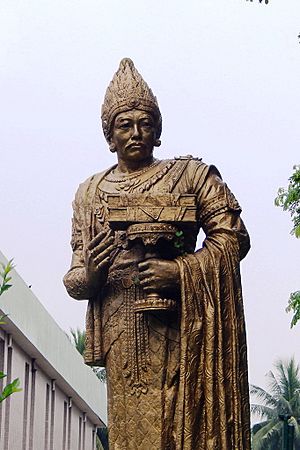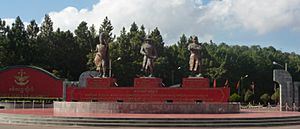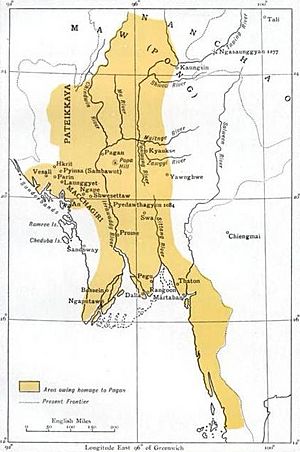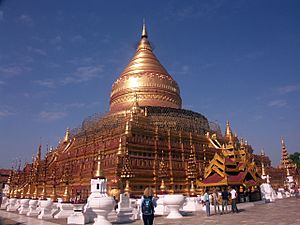Anawrahta facts for kids
Quick facts for kids Anawrahtaအနော်ရထာ |
|||||
|---|---|---|---|---|---|

Statue of Anawrahta
|
|||||
| King of Burma | |||||
| Reign | 11 August 1044 – 11 April 1077 | ||||
| Coronation | 16 December 1044 | ||||
| Predecessor | Sokkate | ||||
| Successor | Saw Lu | ||||
| Born | 11 May 1014 Tuesday, 11th waxing of Nayon 376 ME Pagan (Bagan) |
||||
| Died | 11 April 1077 (aged 62) Tuesday, 3rd waning of Kason 439 ME Pagan |
||||
| Consort | Pyinsa Kalayani Agga Mahethi Saw Mon Hla Manisanda |
||||
| Issue | Kyansittha Saw Lu |
||||
|
|||||
| House | Pagan | ||||
| Father | Kunhsaw Kyaunghpyu | ||||
| Mother | Myauk Pyinthe | ||||
| Religion | Theravada Buddhism converted from Ari Buddhism | ||||
Anawrahta Minsaw (Burmese: အနော်ရထာ မင်းစော, pronounced: [ʔənɔ̀jətʰà mɪ́ɰ̃ sɔ́]; 11 May 1014 – 11 April 1077) was a very important king in Burmese history. He founded the Pagan Empire, which was the first large kingdom in what is now Burma (Myanmar). Many people call him the "father of the Burmese nation" because he united different areas and started many changes that shaped modern Burmese culture.
Anawrahta was the first to bring together the entire Irrawaddy valley. He also made nearby regions like the Shan States and Arakan part of his empire. He even stopped the powerful Khmer Empire from expanding into areas like the Tenasserim coast. This made Pagan one of the two most important kingdoms in mainland Southeast Asia at that time.
King Anawrahta made many big changes in his kingdom. These included new rules for society, religion, and the economy. These changes had a lasting effect on Burmese history. For example, his religious changes helped shape the Burmese culture we know today. He also built special water systems, like weirs, to turn dry lands into rich rice farms. This gave his kingdom a strong economic base. He created a strong government system that later kings followed for over 200 years. Because of Anawrahta, the Burmese language and culture grew strong in Upper Burma.
Anawrahta's influence went beyond Burma. He supported Theravada Buddhism, a type of Buddhism that was struggling in other parts of South and Southeast Asia. He even helped restart Theravada Buddhism in Ceylon (modern-day Sri Lanka), where it began. His success helped Theravada Buddhism grow in other kingdoms like Lan Na (northern Thailand) and Sukhothai (central Thailand) later on. Anawrahta is still one of the most famous kings in Burmese stories and plays.
Contents
Early Life of Anawrahta
Anawrahta was born on May 11, 1014. His birth name was Min Saw (မင်းစော). His father was King Kunhsaw Kyaunghpyu, and his mother was Queen Myauk Pyinthe.
When Min Saw was about six years old, his father, King Kunhsaw, was removed from the throne. Two of his step-brothers, Kyiso and Sokkate, took over. They forced their father to become a monk. Min Saw grew up while his step-brothers ruled. He was allowed to stay at the royal court and was loyal to them. He had two sons, Saw Lu and Kyansittha, by the early 1040s.
How Anawrahta Became King
In 1044, Min Saw started a rebellion. He challenged Sokkate, who was then king, to a fight. The stories say that Min Saw was angry because Sokkate had made Min Saw's mother a queen. Sokkate called Min Saw "brother-son," which Min Saw found insulting.
On August 11, 1044, Min Saw fought Sokkate on horseback near Pagan. Min Saw won the fight, and Sokkate fell into a nearby river. After winning, Min Saw first offered the throne to his father, who was still a monk. But his father refused. So, on December 16, 1044, Min Saw became king. He took the royal name Anawrahta.
Building the Kingdom
When Anawrahta first became king, his kingdom was quite small. It was mainly in central Burma, a dry area. To the north was the Nanzhao Kingdom, and to the east were the Shan Hills. To the south were the Mon people.
Economic Improvements
Anawrahta's first goal was to make his kingdom stronger. He organized every town and village based on how much they could help the kingdom. He worked hard to turn the dry lands of central Burma into rich rice farms. He built many irrigation systems that are still used today. He fixed the Meiktila Lake and built several weirs and canals on the Panlaung and Zawgyi rivers. These areas became known as Ledwin, meaning "the rice country." This region became very important for the economy of Upper Burma.
Military Leaders
Anawrahta also organized his army. He had four main generals, known as the Four Great Paladins:
- Kyansittha, his son and a top general.
- Nyaung-U Hpi, a famous swimmer.
- Nga Htwe Yu, a former toddy tree climber.
- Nga Lon Letpe, a former farmer.
He also had other brave men like Byatta, a Muslim sailor, and his sons, Shwe Hpyin Gyi and Shwe Hpyin Nge. These sons later became famous folk deities (spirits) in Burmese stories.
Expanding the Pagan Empire
By the mid-1050s, Anawrahta's changes had made Pagan a strong power. He then began to expand his kingdom. Over the next ten years, he created the Pagan Empire.
Bringing in the Shan Hills
Anawrahta first focused on the Shan Hills to the east and north. He visited the closer Shan Hills and received gifts from their chiefs. Later, after a trip to the Nanzhao Kingdom, more Shan chiefs offered their loyalty. However, their loyalty was not always strong. So, Anawrahta built 43 forts along the eastern hills to keep control. Many of these places are still villages today.
Conquering Lower Burma
Next, Anawrahta turned his attention to the Mon-speaking kingdoms in the south. He first gained the loyalty of the ruler of Pegu (Bago). But the Thaton Kingdom refused to join him. In early 1057, Anawrahta's armies, led by his "Four Paladins," attacked Thaton. After a three-month siege, Pagan forces conquered the city on May 17, 1057.
According to traditional stories, Anawrahta invaded Thaton because its king, Manuha, refused to give him a copy of the Pāli Canon (Theravada Buddhist scriptures). Anawrahta had recently become a follower of Theravada Buddhism because of a monk named Shin Arahan, who was from Thaton. In reality, Anawrahta likely wanted to control the area and stop the Khmer Empire from expanding.
The conquest of Thaton was a major event in Burmese history. It is said that Anawrahta brought over 30,000 people, including many skilled workers, back to Pagan. These people helped build the thousands of temples and monuments that still stand in Pagan today. This conquest also helped Pagan connect more with India and Ceylon (Sri Lanka), which were important centers of Theravada Buddhism.
Controlling Arakan
Anawrahta also conquered northern Arakan (Rakhine). He marched his army through the mountains and attacked Pyinsa, the capital of Arakan. He tried to bring back a giant Buddha statue but could not. However, he did take valuable gold and silver items from the shrine.
Anawrahta's control over Arakan was not very strong because of the mountains separating them. It was more like a raid to stop Arakanese attacks on Burma. Still, Pagan kings continued to have some influence over Arakan for many years. The Burmese language and writing also became more common in Arakan over time.
Relations with Other Kingdoms
As his kingdom grew, Anawrahta came into contact with other powerful kingdoms. These included the Nanzhao Kingdom in the northeast and the Khmer Empire in the southeast. He also helped his fellow Theravada Buddhist kingdom, Ceylon.
Dealing with the Khmer Empire
Pagan's conquest of Thaton affected other Mon kingdoms. Anawrahta asked for loyalty from Hariphunchai and Dvaravati (in modern-day Thailand). Hariphunchai agreed, but the Khmer Empire, which ruled Dvaravati, instead invaded the Tenasserim coast. Anawrahta sent his armies, led by the Four Paladins, and they pushed back the Khmer invaders.
Visiting the Nanzhao Kingdom
After stopping the Khmer, Anawrahta turned his attention to the Nanzhao Kingdom in the northeast. He led a campaign to Dali, the capital of Nanzhao. He said he was looking for a Buddha's tooth relic. This was likely a way to demand their loyalty. The Nanzhao ruler did not give him the relic, but they exchanged gifts and had friendly talks. The Nanzhao ruler gave Anawrahta a jade image that had touched the tooth.
Helping Ceylon
In 1069, King Vijayabahu I of Ceylon asked Anawrahta for help. Ceylon was fighting against invaders from the Chola kingdom. Anawrahta sent ships with supplies to help Buddhist Ceylon. In 1071, after defeating the Cholas, Vijayabahu asked Anawrahta for Buddhist scriptures and monks. The wars had left Ceylon with very few monks. Anawrahta sent monks and scriptures, along with a white elephant as a gift. The Burmese monks helped train new monks in Ceylon. In return, the Ceylonese king gave Anawrahta a copy of the Buddha Tooth relic. This copy was placed in the Lawkananda Pagoda in Pagan.
Anawrahta's Administration
Uniting the People
One of Anawrahta's greatest achievements was bringing different groups of people together to form one nation. He made sure that his own people, the Burmans, did not act superior to others. He respected the Pyus, who were an older group. He also encouraged his people to learn from the Mons.
Anawrahta replaced the kings of Lower Burma with governors. He allowed the king of Pegu to remain a vassal (a ruler who accepts a higher king) for a while, but after that king died, Anawrahta appointed a governor. In distant areas like Arakan and the Shan Hills, he allowed local chiefs to continue ruling their own lands.
Religious Changes
In 1056, a Mon monk named Shin Arahan visited Pagan. He convinced King Anawrahta to change from his old religion, Ari Buddhism, to Theravada Buddhism. Anawrahta was not happy with the power of the Ari monks. He felt they were not following good religious practices. In Theravada Buddhism, he found a new way to guide his people.
From 1056, Anawrahta started many religious changes. These changes became stronger after he conquered Thaton, which brought more scriptures and monks to Pagan. He reduced the power of the Ari monks. He said that people no longer had to give their children to the priests. Those who were controlled by the priests became free. Some Ari monks changed their ways, but many were sent away. Some fled to Popa Hill and the Shan Hills.
Anawrahta also used traditional nat spirits (local spirits) to help people accept the new religion. When asked why he allowed nats in Buddhist temples, he said, "People will not come for the new faith. Let them come for their old gods, and slowly they will be won over."
Shin Arahan also encouraged Anawrahta to make Theravada Buddhism more pure. Anawrahta invited scholars from Mon lands, Ceylon, and India to Pagan. This helped to make Theravada Buddhism more traditional. However, these changes did not happen overnight. It took a long time for Theravada Buddhism to spread fully throughout Upper Burma. Even today, Burmese Buddhism still has some elements of older beliefs and Hindu influences.
Anawrahta was the first of the "Temple Builders" of Pagan. His most famous temple is the Shwezigon Pagoda. He started building it in 1059, but it was still not finished when he died 18 years later. He also built the Shwesandaw Pagoda south of Pagan to keep hair relics.
Burmese Alphabet
For a long time, people thought that Anawrahta ordered the creation of the Burmese alphabet around 1058, based on the Mon script. However, newer research shows that the Burmese alphabet was used even earlier, possibly since 1035 or even 984 CE.
Anawrahta's Leadership Style
Anawrahta was a very active king who brought many important changes to his kingdom. People respected and feared him, but perhaps did not love him. Still, he was able to make many of his big plans happen.
Death of Anawrahta
Anawrahta died on April 11, 1077, near Pagan. Stories say that his enemies attacked and killed him. They hid his body so well that it was never found.
Anawrahta's Lasting Impact

Anawrahta is seen as one of the greatest kings in Burmese history. He created the first strong kingdom that led to modern Burma. He not only made the Pagan Kingdom much larger but also set up new ways of governing. These changes allowed his empire to control the Irrawaddy valley for another 250 years.
Anawrahta's influence spread far beyond Burma. His success helped the Burmese language and culture grow strong. His support for Theravada Buddhism gave this religion a safe place to thrive when it was struggling elsewhere. He helped restart Theravada Buddhism in Ceylon. The success of the Pagan dynasty also helped Theravada Buddhism grow in other parts of Southeast Asia, like Lan Na, Siam, Lan Xang, and Cambodia, in the 13th and 14th centuries.
Commemorations
Anawrahta is remembered in many ways today:
- Anawrahta Road is a main street in Yangon.
- UMS Anawrahta is the name of a ship in the Myanmar Navy.
- Team Anawrahta is one of the student teams in Burmese schools.
Images for kids
See also
 In Spanish: Anawrahta para niños
In Spanish: Anawrahta para niños





